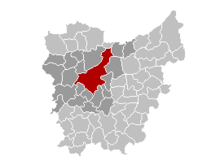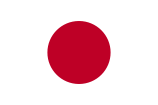Ghent
| Ghent Gent (Dutch) Gand (French) |
|||
|---|---|---|---|
 |
|||
|
|||
 |
|||
| Sovereign state | |||
| Region | |||
| Community | |||
| Province | |||
| Arrondissement | Ghent | ||
| Coordinates | |||
| Area | 156.18 km² | ||
| Population – Males – Females - Density |
233,120 (January 1, 2006) 48.93% 51.07% 1493 inhab./km² |
||
| Age distribution 0–19 years 20–64 years 65+ years |
(01/01/2006) 20.92% 61.21% 17.88% |
||
| Foreigners | 7.31% (01/07/2005) | ||
| Unemployment rate | 14.22% (January 1, 2006) | ||
| Mean annual income | 13,617 €/pers. (2003) | ||
| Mayor (list) | Daniël Termont (SP.A) | ||
| Governing parties | SP.A, VLD, Vl.Pro | ||
| Postal codes | 9000-9052 | ||
| Area codes | 09 | ||
| Website | www.gent.be | ||
Ghent (IPA: /ˈɡɛnt/; Gent IPA: [ʝɛnt] in Dutch, Gand [ɡɑ̃] in French, and formerly Gaunt in English) is a city and a municipality located in the Flemish region, Belgium. It is the capital and biggest city of the East Flanders province. The city started as a settlement at the confluence of the Rivers Scheldt and Lys and became in the Middle Ages one of the largest and richest cities of northern Europe. Today it is a busy city with a port and a university.
The municipality comprises the city of Ghent proper and the towns of Afsnee, Desteldonk, Drongen, Gentbrugge, Ledeberg, Mariakerke, Mendonk, Oostakker, Sint-Amandsberg, Sint-Denijs-Westrem, Sint-Kruis-Winkel, Wondelgem and Zwijnaarde. With 237,250 inhabitants in the beginning of 2008,[1] Ghent is Belgium's second largest municipality by number of inhabitants. The metropolitan area, including the outer commuter zone, covers an area of 1,205 km² and has a total population of 594,582 as of 1 January 2008, which ranks it as the fourth most populous in Belgium.[1][2] The current mayor of Ghent, Daniël Termont, leads a coalition of the SP.a/VlaamsProgressieven and VLD.
Every year a ten day long street festival is held called the "Ghent Fests" (Gentse Feesten in Dutch). About 2 million visitors attend the festival every year.
Contents |
Geography
Municipalities
After the 1965 and 1977 fusions the city is made up of:

|
Neighbouring municipalities
- Wachtebeke
- Lochristi
- Destelbergen
- Melle
- Merelbeke
- De Pinte
- Sint-Martens-Latem
- Deinze
- Nevele
- Lovendegem
- Evergem
- Zelzate
History

Archeologic evidence shows human presence in the region of the confluence of Scheldt and Lys going back as far as the Stone Age and the Iron Age[3]. Most historians believe that the older name for Ghent, 'Ganda' is derived from the Celtic word 'ganda' which means confluence[3]. There are no written records of the Roman period but archeological research confirms that the region of Ghent was further inhabited.
When the Franks invaded the Roman territories (from the end of the 4th century and well into the 5th century) they brought their language with them and Celtic and Latin were replaced by Old Dutch.
Around 650 Saint Amand founded two abbeys in Ghent: the Saint Peter Abbey and the St. Bavo's Abbey . The city grew from several nuclei, the abbeys and a commercial centre. Around 800 Louis the Pious, son of Charlemagne, appointed Einhard, the biographer of Charlemagne, as abbot of both abbeys. In 851 and 879 the city was however attacked and plundered twice by the Vikings.
The city recovered and flourished from the 11th century on. Until the 13th century Ghent was the biggest city in Europe after Paris; it was bigger than London, Cologne or Moscow. Within the city walls lived up to 65,000 people. Today, the belfry and the towers of the Saint Bavo Cathedral and Saint Nicholas' Church are just a few examples of the skyline of the period.

The rivers flowed in an area where a lot of land was periodically inundated. These richly grassed 'meersen' ("water-meadows": a word related to the English 'marsh', but not meaning exactly the same, a 'meers' is not permanently under water) were ideally suited for herding sheep, the wool of which was used for making cloth. In fact, Ghent was during the Middle Ages the most important city for cloth.
The wool-industry, originally established at Bruges, created the first European industrialized zone in Ghent in the High Middle Ages. The mercantile zone was so highly-developed that wool had to be imported from England. This was one of the reasons for Flanders' good relationship with England. Ghent was the birthplace of John of Gaunt, Duke of Lancaster. The trade with England suffered significantly during the Hundred Years' War.
The city recovered in the 14th century, while Flanders was united with neighbouring provinces under the Dukes of Burgundy. High taxes led to a rebellion and eventually the Battle of Gavere, in which Ghent suffered a terrible defeat at the hands of Philip the Good. Around this time the center of gravity in the Low Countries started to shift from Flanders (Bruges–Ghent) to Brabant (Antwerp–Brussels), although Ghent would continue to play an important role.

In 1500 Juana of Castile gave birth to Charles V, who became Holy Roman Emperor and King of Spain. Although native to Ghent, he punished the city after the 1539 Revolt of Ghent and obliged the city's nobles to walk in front of the emperor barefoot with a noose (Dutch: strop) around the neck; since this incident, the people of Ghent have been called "Stroppendragers" (noose bearers). The Saint Bavo Abbey was abolished, torn down, and replaced with a fortress for Spanish troops. Only a small portion of the abbey was spared demolition.
The late 16th and the 17th century brought devastation because of the Religious wars. At one time Ghent was a Calvinistic republic, but eventually the Spanish army reinstated Catholicism. The wars ended the role of Ghent as a center of international importance.
In the 18th and 19th century Ghent the textile industry flourished again in Ghent. Lieven Bauwens introduced the first mechanical weaving machine on the European continent, of which he smuggled the plans out of England, in 1800.
Ghent was also the site of the signing of the Treaty of Ghent which formally ended the War of 1812 between Britain and the United States of America. After the battle of Waterloo Ghent became a part of the United Kingdom of the Netherlands for 15 years. In this period Ghent got its own university (1817) and a new connection to the sea (1824–27).
After the Belgian Revolution, with the loss of port access to the sea for more than a decade, the local economy collapsed and the first Belgian trade-union originated in Ghent. In 1913 there was a World exhibition in Ghent. As a preparation for these festivities the Sint-Pieters railway station, was completed in 1912.
Tourism

Architecture
|
Historical centre of Ghent – from left to right: Old post office, Saint-Nicholas Church, Belfry, and Saint Bavo Cathedral.
|
|
Ghent at Night
|
Much of the city's medieval architecture remains intact and is remarkably well preserved and restored. Its centre is the largest carfree area in Belgium. Interesting highlights are the Saint Bavo Cathedral with the Ghent Altarpiece, the belfry, the Gravensteen castle, and the splendid architecture along the old Graslei harbour. Ghent established a nice blend between comfort of living and history – it is not a city-museum. The city of Ghent houses also three béguinages and numerous churches, among which the Saint-Jacobs church and the Saint-Nicolas Church are the most beautiful examples.
In the nineteenth century Genth's most famous architect, Louis Roelandt, built the university hall Aula, the opera and the main courthouse. Highlights of modern architecture are the university buildings (the Boekentoren or Book Tower) by Henry Van de Velde. There are also few theatres from diverse periods.
The beguinages, as well as the belfry and adjacent cloth hall, were recognized by UNESCO as World Heritage Sites in 1998 and 1999.
Museums
Important museums in Ghent are the Museum voor Schone Kunsten (Museum of Fine Arts), with paintings by Hieronymus Bosch, Jean Fouquet, and many Flemish masters; the SMAK or Stedelijk Museum voor Actuele Kunst (City Museum for Contemporary Art), with works of the 20th century, including Joseph Beuys and Panamarenko; and the Designmuseum. The Huis van Alijn (House of the Alijn family) was originally a beguinage and is now a museum for folk art. This museum often presents theatre and puppet shows for children. There is also a museum presenting the industrial strength of Ghent, the Museum voor Industriële Archeologie en Textiel or MIAT. Here you can find recreations of workshops and stores from the 1800s and can see the spinning and weaving machines that remain in this building what was once a weaving mill.
Restaurants and culinary traditions
As most Belgian cities, Ghent offers a rich variety of local and foreign cuisine. Especially the quarter called "Patershol" has a concentration of restaurants. The "Sleepstraat" a little bit further north houses a number of Turkish restaurants and food bars.
In Ghent and other regions of East-Flanders, bakeries sell a donut-shaped bun called a "mastel". "Mastellen" are also called "Saint Hubert bread", because on the Saint's feast day, which is 3 November, the bakers bring their batches to the early Mass to be blessed. Traditionally, it is thought that blessed mastellen immunize against rabies.
Festivities
The city is host to some big cultural events such as the Gentse Feesten, I Love Techno, "10 Days Off" musical festival, Flanders International Film Festival Ghent (with the World Soundtrack Awards) and the Internationaal Festival van Vlaanderen Gent. Also, every five years, a huge botanical exhibition (Gentse Floraliën) takes place in Ghent, attracting numerous visitors to the city.
Economy
The port of Ghent, in the north of the city, is the third largest port of Belgium. It is accessed by the Ghent-Terneuzen Canal, which ends near the Dutch port of Terneuzen on the Western Scheldt. The port houses, among others, big companies like Sidmar, Volvo Cars, Volvo Trucks, Volvo Parts, Honda, and Stora Enso.
The Ghent University and a number of research oriented companies are situated in the central and southern part of the city.
As the biggest city of East-Flanders, Ghent has many hospitals, schools and shopping streets.
Tourism is increasingly becoming a major employer in the local area.
Transport
As one of the largest cities in Belgium, Ghent has a highly developed transportation system.
- By car the city is accessible by two of the country's main roads:
- In addition Ghent also has two ringways:
- The R4: connects the outskirts of Ghent with each other and the surrounding villages, and also leads to the E40 and E17 roads.
- The R40: connects the different downtown quarters with each other, and provides access to the main avenues.
- The municipality of Ghent comprises five train stations:
- Gent-Sint-Pieters Station: an international train station with connections to Bruges, Brussels, Antwerp, Kortrijk, other Belgian towns and Lille. The station also offers a direct connection to Brussels Airport.
- Gent-Dampoort Station: an intercity train station with connections to Sint-Niklaas, Antwerp, Kortrijk and Eeklo.
- Gentbrugge Station: a regional train station in between the two main train stations, Sint-Pieters and Dampoort.
- Wondelgem Station: a regional train station with connections to Eeklo once an hour.
- Drongen Station: a regional train station in the village of Drongen with only a limited number of trains a day.
- Ghent has an extensive web of public transport lines, operated by De Lijn:
- Tram (see pictures below):
- Line 1: Flanders Expo - Sint-Pieters-Station - Korenmarkt (city centre) - Evergem
- Line 4: Sint-Pieters-Station - Muide - Korenmarkt (city centre) - Zuid - Moscou
- Line 21: Zwijnaardebrug - UZ - Sint-Pieters-Station - Zonnestraat (city centre) - Zuid - Melle Leeuw
- Line 22: Zwijnaardebrug - UZ - Sint-Pieters-Station - Zonnestraat (city centre) - Zuid - Gentbrugge
- Trolleybus (unique in Belgium; see picture below):
- Line 3: Mariakerke - Korenmarkt (city centre) - Dampoort-Station - Gentbrugge
- City buses (see picture below):
- Line 5: Van Beverenplein - Sint-Jacobs (city centre) - Zuid - UZ - Zwijnaarde
- Line 6: Watersportbaan - Zuid - Dampoort-Station - Wondelgem - Mariakerke
- Line 9: Mariakerke - Malem - Sint-Pieters-Station - Gentbrugge
- Line 17/18: Drongen - Korenmarkt (city centre) - Dampoort-Station - Oostakker
- Line 38/39: Blaarmeersen - Korenmarkt (city centre) - Dampoort-Station - Sint-Amandsberg
- At Sint-Pieters-Station and the Zuid bus station there are several regional buses as well.
- Tram (see pictures below):
When arriving in Ghent, it is best to leave cars in Park & Ride zones next to the road. The actual city centre is a car free area, and parking is difficult and expensive in the city. On weekends, night buses provide transportation through the night.
Famous people

See also: Notable people from Ghent
- Saint Bavo, patron saint of Ghent (589-654)
- Henry of Ghent, scholastic philosopher (c. 1217-1293)
- Jacob van Artevelde, statesman and political leader (c. 1290-1345)
- John of Gaunt, 1st Duke of Lancaster (1340-1399)
- Jan van Eyck, painter (c. 1385-1441)
- Hugo van der Goes, painter (c. 1440-1482)
- Jacob Obrecht, composer of the Renaissance (c. 1457-1505)
- Charles V, Holy Roman Emperor, Karel V, Charles Quint (1500-1558)
- Cornelius Canis, composer of the Renaissance, music director for the chapel of Charles V in the 1540s-1550s
- Daniel Heinsius, scholar of the Dutch Renaissance (1580-1655)
- Caspar de Crayer, painter (1582-1669)
- Frans de Potter, writer, (1834-1904)
- Jan Frans Willems, writer (1793-1846)
- Joseph Guislain, physician (1797-1860)
- Hippolyte Metdepenningen, lawyer and politician (1799-1881)
- Louis XVIII of France was exiled in Ghent during the Hundred Days in 1815
- Charles John Seghers, Jesuit clergyman and missionary (1839-1886)
- Victor Horta, Art Nouveau architect (1861-1947)
- Maurice Maeterlinck, poet, playwright, essayist, recipient of the Nobel Prize in Literature (1862-1949)
- Frans Rens, writer, (1805-1874)
- Leo Baekeland, chemist and inventor of Bakelite (1863-1944)
- Pierre Louÿs, poet and romantic writer (1870-1925)
- Marthe Boël, feminist (1877-1956)
- Corneille Jean François Heymans, physiologist and recipient of the Nobel Prize in Physiology or Medicine (1892-1968)
- Suzanne Lilar, essayist, novelist, and playwright (1901-1992)
- Jean Daskalidès, gynecologist and founder of Leonidas chocolates (1922-1992)
- Jacques Rogge, International Olympic Committee President (1942-)
- 2ManyDJs, Soulwax musicians
- Gabriel Rios, musician
- Kristof Ongenaet, basketball player
Sister Cities
 United Kingdom: Nottingham
United Kingdom: Nottingham Estonia:
Estonia:  Tallinn
Tallinn Germany:
Germany:  Wiesbaden
Wiesbaden Japan: Kanazawa, Ishikawa Prefecture
Japan: Kanazawa, Ishikawa Prefecture Germany: Melle
Germany: Melle Morocco: Mohammedia
Morocco: Mohammedia France: Saint-Raphaël
France: Saint-Raphaël United States:
United States:  Des Moines, Iowa
Des Moines, Iowa
See also
- List of Mayors of Ghent
- Ghent University
- K.A.A. Gent
External links
- Official website - Information available in Dutch, English, French and German
- Panorama 360° from St-Bavo's place between Saint Bavo Cathedral and the Belfry it is exactly as if you were there !
- Panorama 360° from the Sint-Michiels bridge in Ghent it is exactly as if you were there !
- Gentblogt, city blog / webzine
- Beyondjazz.net - Beyondjazz.net Ghent Cityguide
- An image gallery - with 21 pictures about Gent
- Virtual Ghent- 360˚ virtual tour of the city
- Navigate between panoramic images - panoramic images of Ghent
- Ghent photo gallery
- Photos of Gent in 3d (Anaglyphs)
- Ghent features and map
References
- ↑ 1.0 1.1 Statistics Belgium; Population de droit par commune au 1 janvier 2008 (excel-file) Population of all municipalities in Belgium, as of 1 January 2008. Retrieved on 2008-10-19.
- ↑ Statistics Belgium; De Belgische Stadsgewesten 2001 (pdf-file) Definitions of metropolitan areas in Belgium. The metropolitan area of Ghent is divided into three levels. First, the central agglomeration (agglomeratie) with 278,457 inhabitants (2008-01-01). Adding the closest surroundings (banlieue) gives a total of 423,320. And, including the outer commuter zone (forensenwoonzone) the population is 594,582. Retrieved on 2008-10-19.
- ↑ 3.0 3.1 "History of Ghent". www.gent.be. Retrieved on 2006-05-05.
|
||||||||||||||||||||

